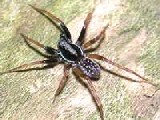Eugenio Marķa de Hostos Community College of The City University of New York |
 |
ACTIVITIES |
| Description of BRF Project |
|
* * * * * * * * * * * * * * * * * * * * * *
 |
The Insect and Arachnid Diversity
of Black Rock Forest
* * * * * * * * * * * * * * * * * * * * * *
____________________________________
Eugenio Marķa de Hostos Community College
of The City University of New York
500 Grand Concourse
Bronx, NY 10451
Telephone : 718-518-4444
____________________________________
Project
The Insect and Arachnid Diversity
of Black Rock Forest
Professor
Vladimir OVTCHARENKO
PROJECT DESCRIPTION
INTRODUCTION
This project is closely related with our previous project "Biodiversity of Spiders of BRF" and combines research and educational approaches to biodiversity studies looking in particular at the biodiversity of the Black Rock Forest arthropods: arachnids and insects. The project has two major parts - namely, research and education.
The first part of the project comprises a research study of the biodiversity of the BRF arachnids and insects. Before our research, arachnids (particular spiders) were virtually unknown in Black Rock Forest . Spiders are predators without food specialization; therefore, they are excellent models for biodiversity research. Arachnids and insects occur in almost all ecosystems from deserts to the top of mountains. In particular, forests have a more diverse spider (arachnids) fauna than most other ecosystems.Insects and arachnids are incalculably valuable to man. Usually, we think of them in a negative context. Insects eat our food, feed on our blood and skin, contaminate our dwellings, and transmit horrible diseases. But without them, we could not exist. They are a fundamental part of our ecosystem. A brief and incomplete list of their positive roles would include the pollination of many, perhaps most higher plants; the decomposition of organic materials, facilitating the recycling of carbon, nitrogen, and other essential nutrients; the control of populations of harmful invertebrate species (including other insects); the direct production of certain foods (honey, for example); and the manufacture of useful products such as silk and shellac.
At a State level the Class Arachnida and Class Insecta of New York state are still very poorly known. For example, the last list of New York State spiders was completed by Crosby and Bishop in 1928 and they included 174 genera and 576 species. Kaston (1981) in his book "Spiders of Connecticut" recorded 184 genera and 462 species of spiders from Connecticut State , and 224 genera and 597 species from adjunct territories of Connecticut State (including the territory of New York east towards Hudson River ). This example shows that the spider fauna of a much smaller state, Connecticut , is currently represented by more species than there are in the whole of New York State . Obviously, this poor state of knowledge needs to be addressed. As a result, our arachnological research in BRF has become the first spider survey for the last 70 years and in three (1999 - 2003) years of the project development we have found 300 species of spiders in BRF.
Interactive multimedia keys of all orders of arachnids and insects are an additional way of biodiversity research in BRF and we will create these keys on the basis of LucID program. LucID is a multimedia expert system designed specifically to help users make a correct identification of a biological specimen. LucID system is very widely used for taxonomical purposes in biology and medicine. At the same time only a few LucID identification keys of arachnids and insects exist nowadays. We are planning to create the LucID identification key of BRF arachnid and insect orders but eventually it will be the key for the whole territory of north-eastern parts of the USA and Canada .
The creation of the website “Gallery of Arachnid and Insect Orders” will be an important aspect of this project. Both of our current websites, “Gallery of Spiders” and “Distribution of Spiders in BRF,” are extremely popular. We received numbers of inquiries for permission to use images and information from these websites for educational and research projects at schools and universities in this country, Canada , Israel , Germany , and Brazil .
The educational aspect involves a special project called "Field Biodiversity", which is sponsored by the American Museum of Natural History. This project is aimed at two different groups: high school students and high school teachers. It involves one-day classes in BRF for students and six-week classes for teachers (with some classes in BRF). The idea is to show students the general principles of studying biodiversity in the field. The course concentrates on arachnids and other invertebrates. Focusing on invertebrates for biodiversity research is still rare. However, they are a remarkably diverse group in any ecosystem and occur throughout the year. In BRF these groups will contain mostly arachnids and insects.
The data generated in the field are used as a general manual for teaching biodiversity to high school students at the AMNH and are also studied in the distance-learning course "The Study of Spiders" created by the AMNH for high school teachers. The teachers are studying spiders, arachnids and insects using Internet connections and all field classes are based on the data from the BRF.An important aspect of the Project 2005 will be to improve the database driven web site (http://research.amnh.org/iz/blackrock) where both students and teachers can share the data collected in the field using as a model the "Biodiversity Counts" web site produced by the National Center for Science Literacy, Education and Technology based at the AMNH. PI's has extensive experience in creating and using web pages to help produce sites for the BRF project "Biodiversity of spiders of the Black Rock Forest" (http://research.amnh.org/iz/blackrock), the NSF
PEET project "Biodiversity of Australasian ground spiders"
(http://research.amnh.org/iz/spiders), "Biodiversity Counts"
(http://www.amnh.org/science/biodiversity/biodiversity_counts/index.cfm).
RESEARCH DESIGN
In the first year of the project, from May to December 2005, we will collect all arachnids and insects in the BRF using different techniques, mostly sifting leaf leather and using Berlase funnel. All collected material will be identified. The web site "Biodiversity of Spiders and Insects of the Black Rock Forest " located on the server of the American Museum of Natural History (http://research.amnh.org/iz/blackrock) will be completely changed. The "Identification Key of BRF Arachnids and Insects Orders” also will be completed and published on the AMNH website (http://research.amnh.org/iz/blackrock). Websites "Gallery of Arachnids and Insects of BRF" will be created on the BRF website. Arachnids and Insects collected in 2005 will be arranged in a special voucher collection and deposited to the BRF and AMNH for the future research and educational purposes.
In the first year of the project we are planning to create a completely new interactive identification key of the BRF arachnids and insects on the basis of LucID program. LucID is a multimedia expert system designed specifically to help users make a correct identification of a biological specimen. A major feature of LucID is its ease of use. The program comes in two parts, a builder used in the creation of keys, and a player that enables the user to identify specimens using the key. The Builder allows teachers, lecturers, or taxonomists to build and modify identification or diagnostic keys to meet the particular requirements of specific users. The Player allows users to browse LucID keys, which can incorporate text, images, video and sound to help the user select those taxonomic and diagnostic characteristics which best describe the particular case being investigated. As the user selects character states, those taxa or causes of the problem to which these character states do not apply are rejected, reducing the list of possible taxa or causes. Once the specimen has been identified to a particular taxon or a diagnosis made, LucID then provides multimedia fact sheets, sub-keys, or links to web sites for further information or recommendations. We are planning to provide interactive key for a major orders of arachnids and insects of the BRF and adjunct territories. Therefore this Interactive LucID keys will be working not only on the territory of the BRF but actually for the whole north-eastern part of the USA and Canada .In first year of the project we are planning to continue extensive collecting of arachnids: pseudoscorpiones, opiliones, mites, ticks, and spiders in the BRF using all known techniques, especially sifting leaf leather, vibration technique, and using Berlase funnel. We will continue our collecting field trips with students of AMNH in the spring and summer months, also at the beginning of spring we are planning to do pitfall trapping and will continue to collect throughout 2005. In this year of the project we also intend to involve a postdoctoral student (Andrei Tanasevitch, Ph.D.) who has extensive experience with invertebrate of the BRF (creation of the web site, collection, identification, illustration, description). He worked in the BRF for two months (2003) collecting additional spiders, illustrating spiders for “Identification Keys” and creating image databases of the BRF spiders. In this project he is going to stay in the BRF for approximately two months as well and study arachnids and insects from the middle of May till the middle of July 2005.
The "Field Guide” and “Gallery of Arachnides and Insects of BRF” websites will be created in this project. Each image from gallery will be linked up to a short description of arachnid or insect order, to the description of major representatives in order, and to the general Identification Key. Totally, the "Gallery" will include five orders of arachnids and 28th orders of insects.This is example of arachnid order description; the same descriptions will be provided for all five orders of arachnids and 28th orders of insects:
Pseudoscorpions (Order Pseudoscorpionida)
Pseudoscorpions are small, flat arachnids, usually less than 5 mm long. Like true scorpions, they have enlarged, pincer-like pedipalps, but the short, oval abdomen does not have a tail or stinger. Some species have 2 - 4 simple eyes; others do not have eyes. Many species have poison glands in the pedipalps, which are used to subdue insect prey and small invertebrates. Pseudoscorpions also have silk glands, but unlike spiders, which have them at the tip of the abdomen, the duct openings are located on the jaws, or chelicerae. They use this silk to spin cocoons, in which they “over-winter” and molt. The male in one species produces another kind of silk from the rectum, spinning threads that direct the female to the stalked sperm packet. In most species, the female's brood pouch remains attached to the female's abdomen, and hatchlings stay in the pouch, feeding on a milk like liquid from the female's ovaries. In some species, the female abandons the pouch, and the embryos develop unattended. Often young require several years to mature to adults. Some species can live up to 4 years.
Pseudoscorpions are common in many different habitats - at the seashore, in caves, in houses between the pages of books, and in woods among mosses and under loose bark, leaves, and stones. They can maneuver with great ease, moving forward, backward, and sideways. Frequently, they latch onto large insects, especially flies and beetles, and ride them to a new location. There are over 350 North American species, and about 2,500 species known worldwide.
Example of the description of major representatives in the Order Pseudoscorpions:
CHERNETIDS (Family Chernetidae)
Members of this family of common pseudoscorpions live in many different habitats, ranging from the woods under leaf litter or bark to deserts or homes. These small arachnids, 2 - 4 mm long, have 5-segmented legs and are usually tan to dark brown. Some species have 2 eyes, while others have none. The pincer-like pedipalps contain well-developed venom glands and ducts in the movable part of the pincer, but are poorly developed or absent in the fixed part. Most species are predators, feeding on small flies, bark lice, butterflies and their caterpillars, ants, mites, and small earthworms. Some of the species are found under the elytra of long-horned beetles, where they prey on mites on the beetles' bodies. Females in this family carry the brood pouch until the young hatch. Some females construct a brood nest.
Class Arachnida (spiders, ticks, mites). The arachnid class contains the five following orders in the BRF: Pseudoscorpiones (Chelonethida), Opiliones (Phalangida or daddy long legs), Araneae (spiders), Parasitiformes (ticks and parasitiform mites), Acariformes (acariform mites).
The Insect Class contains the 28th following Insect Orders in the BRF:
Entognatha: Diplura (diplurans), Collembola (springtails), Protura (proturan) Microcoryphia (jumping bristletail), and Thysanura (silverfish).
Subclass Pterygota (winged insects): Ephemeroptera (mayflies), Odonata (dragonflies), Orthoptera (grasshoppers, crickets, katydids), Mantodea (mantises), Blattaria (cockroaches), Isoptera (termites), Dermaptera (earwigs), Plecoptera (stone flies), "Hemipteroids", Psocoptera (book and bark lice), Phthiraptera, Heteroptera (true bugs), Homoptera (cicadas, aphids, scale insects), Thysanoptera (thrips), Neuroptera (lacewings, ant lions, dobsonflies, etc.), Coleoptera (beetles), Strepsiptera, Mecoptera (scorpion flies), Siphonaptera (fleas), Diptera (flies), Trichoptera (caddisflies), Lepidoptera (moths and butterflies), Hymenoptera (ants, bees, wasps).
LITERATURE CITED
CROSBY, C.R., and S.C. BISHOP. 1928: Orders Araneae and Opiliones, in: List of the insects of New York . Mem. 101, Cornell Univ. Agr. Exp. St. , pp.1034-1121.
KASTON, B. J. 1948 (1981). Spiders of Connecticut . Bull. Conn. St. geol. nat. Hist. Surv. 70. 874 pp.
* * * * * * * * * * * * * * * * * * * * * *
* Spiders & Other Arachnids In Black Rock Forest
* * * * * * * * * * * * * * * * * * * * * *
SCIENTIFIC PUBLICATIONS
1977. Ovtsharenko, V. I. The fauna and the distribution of spiders on the territory of the Caucasian Natural Reserve. The Bulletin of the Leningrad University, vol. 2, p.128.
1978. Ovtsharenko, V. I. Spiders of the family Salticidae (Aranei) of the Great Caucasus. Entomology Review, vol. 57, n.3, pp.682-686.
1979. Ovtsharenko, V. I. Spiders of the family Gnaphosidae, Thomisidae, Lycosidae (Aranei) of the Great Caucasus. Proceedings of the Zoological Institute of the Academy of Sciences of the USSR, vol.85, pp.39-53.
1979. Ovtsharenko, V. I. The investigation of the morphological peculiarities of the close species of spiders by means of the Scanning Electronic Microscope. In: Structural - functional aspects of cells, tissues and organ investigation, p.167.
1979. Zyuzin, A. A. and V. I. Ovtsharenko. Taxonomic notes about the Pardosa incerta Nosek (Aranei, Lycosidae), a new species of spiders of the USSR fauna. Proceedings of the Zoological Institute of the Academy of Sciences of the USSR, vol.85, pp.60-64.
1980. Ovtsharenko, V. I. and V. Y. Fet. The fauna and the ecology of the spiders (Aranei) of Badhyz (Turkmen Republic). Entomology Review, vol. 52, n.2, pp.442-447.
1980. Litvinova, A. N., A. S. Shlachtenok and V. I. Ovtsharenko. Fauna of spiders (Aranei) of Byelorussia. Article published by "VINITI" N 3114-80.
1980. Litvinova, A. N., A. S. Shlachtenok and V. I. Ovtsharenko. Level distribution of spiders in pine forests. Vestnik of Byelorussia of the Academy of Sciences, ser. biol., n.6, pp.98-102.
1981. Ovtsharenko, V. I. Morphological structure of pedipalps of the spider Haplodrassus signifer (C. L. Koch)(Aranei, Gnaphosidae). In: Proceedings of the Zoological Institute of the Academy of Sciences of the USSR, vol.106, pp.57-65.
1982. Ovtsharenko, V. I. Systematic list of spiders of the family Gnaphosidae of the European part of the USSR and the Caucasus. Entomology Review, vol. 61, n.4, pp.830-844.
1985. Ovtsharenko, V. I. Cuticular microstructure of the spider family Gnaphosidae (Aranei) and its use in the systematics. Proceedings of the Zoological Institute of the Academy of Sciences of the USSR, vol.139, pp.27-35.
1986. Ovtsharenko, V. I. and Y. P. Krasnobaev. The fauna of the spiders (Aranei) of Kuibishev Region. In: Ecological Investigation in the Central Volga Region, pp.89-98.
1986. Ovtsharenko, V. I. and L. Ojungargal. Spiders of Eastern Mongolia. In: Natural conditions and biological resources of the People's Republic of Mongolia, Moscow, pp.175-176.
1988. Ovtsharenko, V. I. The faunogenetic composition of spiders of the family Gnaphosidae of the USSR. In: XI Europaisches Arachnologisches Colloquium, Helf. 23, pp.261-266.
1988. Ovtsharenko, V. I. and Y. M. Marusik. Spiders of the family Gnaphosidae (Aranei) of the North-East of the USSR (The Magadan Province). Entomology Review, vol. 67, n.1, pp.204-217.
1988. Ovtsharenko, V. I. The modern geographical range of the black widow spider Latrodectus tredecimguttatus (Rossi, 1970) on the territory Palearctic. In: Proceedings of the 5th All-Union meeting "Species and its productiveness in an areal". Tbilisi 10-12, November 1988, pp.203-205.
1989. Ovtsharenko, V. I. Cuticular microstructure of the Gnaphosidae spiders family (Arachnida, Aranei). In: Fauna and ecology of spiders and scorpions. Arachnological Proceeding. Academy of Sciences of the USSR, "Nauka", Moscow, pp.5-14.
1989. Ovtsharenko, V. I. Cuticular microstructure of spiders and its usage in the classification of Gnaphosidae family. Reports from the Department of Biology, University of Turku, n.19, p.70.
1990. Ovtsharenko, V. I. and L. G. Savelyeva. Fauna of spiders of the family Gnaphosidae (Araneae) of Eastern Kazakhstan region. In: Environment Protection and Exploitation of Natural Resources of Priirtishya, Ust-Kamenogorsk, vol.2, pp.194-196.
1991. Ovtsharenko, V. I. and N. I. Platnick. On the spider genus Fedotovia (Araneae, Gnaphosidae). The Journal of Arachnology, vol.19, n.2, pp.102-104.
1991. Platnick, N. I. and V. I. Ovtsharenko. On Eurasian and American Talanites (Araneae, Gnaphosidae). The Journal of Arachnology, vol.19, n.2, pp.115-121.
1992. Ovtsharenko, V. I. Recent geographic distribution of the tribe Pterotrichini (Aranei, Gnaphosidae) in Palearctic. Proceedings of the Zoological Institute of the Academy of Sciences of the USSR, vol.226, pp.129-131.
1992. Ovtsharenko, V. I. Zoogeography of the genus Gnaphosa (Araneae, Gnaphosidae) in North Asia. In: XII International Congress of Arachnology, Brisbane, July 1992. Abstacts. p.59.
1992. Ovtsharenko, V. I., K. Y. Eskov and Y. M. Marusik. The International Arachnological Congress held in Finland. Proceedings of the Zoological Institute of the Academy of Sciences of the USSR, vol.226, pp.138-141.
1992. Ovtsharenko, V. I. and Y. M. Marusik. Taxonomical notes on spiders (Aranei), described by A.Grube. Proceedings of the Zoological Institute of the Academy of Sciences of the USSR, vol.226, pp.70-73.
1992. Ovtsharenko, V.I. and L. G. Savelyeva. Analysis of the fauna of spiders of the family Gnaphosidae of Eastern Kazakhstan. Proceedings of the Zoological Institute of the Academy of Sciences of the USSR, vol.226, pp.194-196.
1992. Antonov S. M., L. G. Magazanik, V. I. Ovtsharenko, Ch. K. Tarabajev and I. M. Fedorova. Mechanisms of action of spider's venom and their role in taxonomy. Proceedings of the Zoological Institute of the Academy of Sciences of the USSR, vol.226, pp.111-112.
1992. Savelyeva, L. G. and V. I. Ovtsharenko. Fauna and distribution of the spider family Gnaphosidae of the eastern Kazakhstan region. In: XII International Congress of Arachnology, Brisbane, July 1992. Abstacts. p.72.
1992. Ovtsharenko, V. I., N. I. Platnick, and D. X. SONG. A Review of the North Asian Ground Spiders of the Genus Gnaphosa (Araneae, Gnaphosidae). Bull. Amer. Mus. Nat. Hist., n. 212, 88 pp.
1993. Ovtsharenko, V. I. The Ground Spider of the Genus Synaphosus (Gnaphosidae): taxonomy and zoogeography. American Arachnology, No. 48, p. 8.
1994. Ovtsharenko, V. I., G. Levy, and N. I. Platnick. A Review of the Ground Spider Genus Synaphosus (Araneae, Gnaphosidae). Am. Mus. Novitates., n.3095, 27 pp.
1994. Ovtsharenko, V. I. The remarkable montane distribution of ground spiders of the genus Parasyrisca (Gnaphosidae) in the Holarctic. American Arachnology, No. 50, p. 7-8.
1995. Ovtsharenko, V. I., N. I. Platnick, and Y. M. Marusik. A Review of the Holarctic Ground Spider Genus Parasyrisca (Araneae, Gnaphosidae). Am. Mus. Novitates., n.3147, 55 pp.
1995. Ovtsharenko, V. I. Spiders at Home. In: Rotunda, Vol.20, No.3, p.4.
1995. Ovtsharenko, V. I. Biodiversity of the North Asian Ground Spider Family Gnaphosidae (Araneae). In: XIIIth International Congress of Arachnology, 3rd to 8th September, 1995, Museum d'histoire naturelle, Geneva, Switzerland. Abstracts. p. 41.
1995. Ovtsharenko, V. I. The Australasian Ground Spiders of the Genus Anzacia (Gnaphosidae): Taxonomy and distribution. American Arachnology, n. 52, p.6.
1995. Ovtsharenko, V. I. and N. I. Platnick. On the Australasian Ground Spider Genera Anzacia and Adelphodrassus (Araneae, Gnaphosidae). Am. Mus. Novitates, n. 3154, 16 pp.
1995. Platnick, N. I. and V. I. Ovtsharenko. An Australian ground spider of the genus Zelotes (Araneae, Gnaphosidae). Rec. West. Aust. Mus., 52: 131-133.
1996. Ovtsharenko, V. I. and Yu. M. Marusik. Additional data on the spiders of the family Gnaphosidae (Aranei) of the North-East of Asia. Entomological studies in the North-East of the USSR, (1991), Vladivostok, pp. 114-130.
1997. Ovtsharenko, V. I. The North Asian Ground Spiders of the Family Gnaphosidae (Araneae): Current Results. In: XVII European Colloquium of Arachnology, Edinburgh, 14th-18th July, 1997, p.26.
1998. Ovtsharenko, V. I. and N. I. Platnick. Taxonomical Notes on the Ground Spider Genus Gnaphosa (Araneae, Gnaphosidae). Am. Mus. Novitates., n.3234, 4 pp.
1998. Ovtsharenko, V. I. Biodiversity of the Australian ground spider of the family Gnaphosidae: preliminary results. In: XIV International Congress of Arachnology, June 28 to July 3, 1998, The Field Museum, Chicago, Illinois, USA. p. 27.
1999. Ovtsharenko, V. I. The gnaphosid genera Homoeothele and Ceryerda (Araneae) in Australia: biology and taxonomy. In: 18th European Colloquium of Arachnology, Stara Lesna, July 12 to 17, 1999, Slovakia, p. 42.
2001. Ovtsharenko, V. I. The Australian Ground Spiders of the Family Gnaphosidae. In XV International Congress of Arachnology, March 26 to 30, 2001, Badplaas, South Africa. p. 123.
2001. Platnick, N. I., V. I. Ovtsharenko, and J. A. Murphy. A Review of the Ground Spider Genus Scotognapha (Araneae, Gnaphosidae) and its Radiation on the Canary and Salvage Islands. Amer. Mus. Novitates., n.3338, 22 pp
Manuscripts in Preparation:
A new species of the ground spider genus Parasyrisca (Araneae, Gnaphosidae) from Eastern Palearctic. (for Amer. Mus. Novitates).
A review of the African ground spiders of the genus Megamyrmaekion (Araneae, Gnaphosidae). (for Amer. Mus. Novitates).
A Review of the Holarctic Ground Spider Genus Coreodrassus (Araneae, Gnaphosidae). (for Amer. Mus. Novitates).
* * * * * * * * * * * * * * * * * * * * * *
MAILING ADDRESS:
Prof. Vladimir OVTCHARENKO
Eugenio María de Hostos Community College
of The City University of New York
500 Grand Concourse
Bronx, NY 10451
Telephone : 718-518-4139
E-mail: vio©hostos.cuny.edu
* * *
Prof. Vladimir OVTCHARENKO
Division of Invertebrate Zoology
American Museum of Natural History
Central Park West at 79th Street, New York
NY 10024-5192.
Phone: (212) 769-5618Fax: (212) 769-5277.
Email: ovtshare©amnh.org* * * * * * * * * * * * * * * * * * * * * *

